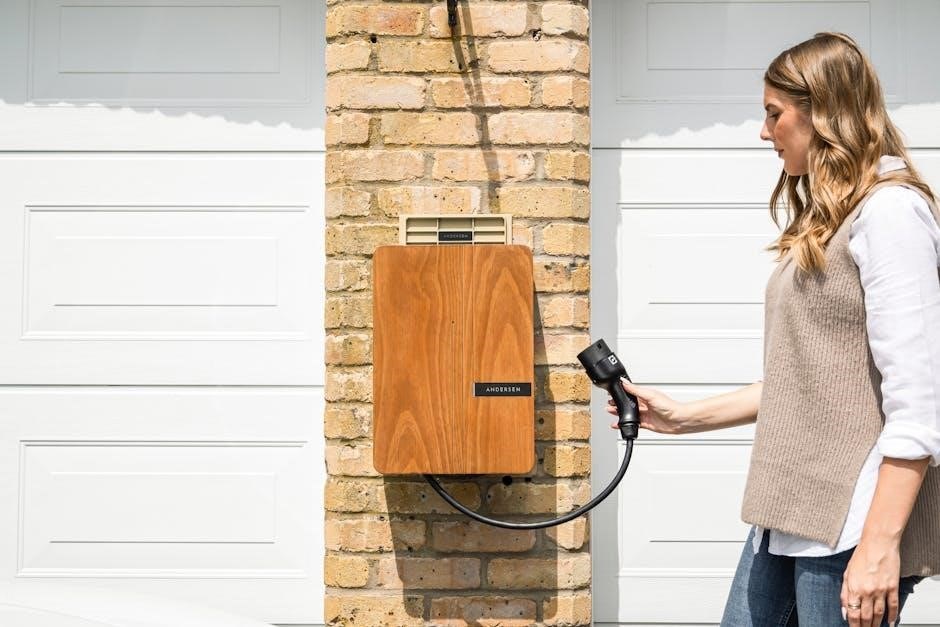Automatic Technology Garage Door Opener Manual: A Comprehensive Guide
Welcome to your comprehensive guide for Automatic Technology garage door openers! This manual unlocks the full potential of your device, providing easy access to installation steps, operating instructions, and troubleshooting tips․
Automatic Technology openers are designed and tested for safe service, provided they are installed and operated according to the safety warnings in this manual․ Failure to comply could result in serious injury or property damage․ This guide provides detailed instructions for your Automatic Technology garage door opener, covering sectional door openers and accessories․
Before starting, ensure the garage door is balanced, as sticking or binding doors must be repaired before installation․ This manual offers comprehensive information, from initial setup to advanced features like auto-close functionality․ Explore our manuals for commercial and gate openers, accessing detailed instructions and troubleshooting tips․
Unlock your Automatic Technology product’s full potential with our owner’s manuals․ Find installation steps, operating instructions, and troubleshooting tips․ We provide manuals for garage door openers, accessories, and remote controls․ This guide ensures safe and reliable operation of your garage door system․ Proper installation and operation are crucial for optimal performance․
Automatic Technology openers are engineered for convenience and security, offering features like TrioCode technology․ Familiarize yourself with your opener’s capabilities, and refer to this manual for any questions or concerns․ Our goal is to ensure you have a seamless and safe experience with your Automatic Technology garage door opener․
Safety Warnings and Precautions
Prioritize safety when installing and operating your Automatic Technology garage door opener․ This opener is designed for safe service, provided it’s installed and operated according to the following warnings․ Failure to comply may result in death, serious personal injury, or property damage․ Always disconnect all electric and battery power before performing any maintenance․

Install the wall transmitter within sight of the garage door, out of children’s reach, at least 1․5m above the floor․ If the closing force at the bottom edge exceeds 400N, install photo-electric beams․ These safety measures are crucial to prevent accidents and ensure safe operation․
Before installation, remove or disengage all garage door locks and mechanisms․ Never plug in the opener before installation․ The garage door must be well-balanced; repair any sticking or binding doors before installing the opener․ These precautions are essential for preventing damage and ensuring smooth operation․
Regularly inspect the garage door system for any signs of wear or damage․ Address any issues promptly to maintain safe operation․ This automatic garage door opener is designed to provide safe service, but only if these precautions are followed diligently․ Keep this manual readily available for future reference․
Manual Disengagement and Re-engagement
Your Automatic Technology garage door opener features a manual disengaging device for use during power outages or emergencies․ To disengage the opener, locate the string handle, usually red, hanging from the motor unit․ Pull the handle down and towards the garage door at an angle․ This disconnects the door from the opener, allowing manual operation․
Ensure the door is fully closed before disengaging to prevent it from suddenly opening․ Once disengaged, you can lift or lower the door manually․ Be cautious, as the door will be heavy without the opener’s assistance․
To re-engage the opener, pull the string handle away from the garage door․ You should hear a click indicating the trolley has reconnected․ Manually move the door until it meets the trolley․ Next, operate the opener using the wall button or remote․ The door should now move under the opener’s power․
If the opener doesn’t re-engage, repeat the process, ensuring the trolley and door align․ Regular practice with manual disengagement and re-engagement will help you become familiar with the process, enabling quick action during emergencies․ Remember to keep the area clear during operation․
Emergency Access in Case of Power Failure

Power failures can disrupt normal garage door operation․ To ensure access during these situations, Automatic Technology openers offer emergency access solutions․ If your garage lacks a pedestrian entrance door, consider installing an emergency access device or a battery backup system․
An emergency access device typically involves an external lock connected to a cable that releases the garage door from the outside․ This allows manual operation of the door even without power․ The battery backup system provides temporary power to the opener, enabling normal operation for a limited number of cycles․
To use the emergency access device, insert the key and turn it to release the cable․ Then, lift the door manually․ For battery backup systems, simply use your remote or wall button as usual․ The system will automatically switch to battery power when a power outage is detected․
Regularly test your emergency access solutions to ensure they function correctly․ Replace batteries in the backup system as needed․ Familiarize yourself with the specific instructions for your device to ensure a smooth and safe operation during a power outage․ Keeping these systems maintained is crucial for reliable emergency access․
Installation Instructions
Prior to commencing installation, ensure the garage door is well-balanced․ Any sticking or binding must be resolved by a qualified installer․ Disconnect all garage door locks and mechanisms․ Never plug in the opener before completing the installation process․
Begin by attaching the rail to the opener motor․ Securely mount the header bracket to the wall above the door․ Connect the rail to the header bracket, ensuring proper alignment․ Attach the door bracket to the top section of the garage door․
Connect the door arm to both the door bracket and the trolley on the rail․ Ensure all connections are secure and properly tightened․ Install safety sensors (photoelectric beams) near the bottom of the door, following the manufacturer’s guidelines․ These beams are crucial for preventing the door from closing if an obstruction is detected․
Connect the opener to a properly earthed 240V mains power outlet installed by a qualified electrician․ If an emergency access device is required, install it according to its specific instructions․ Test the door’s operation, ensuring smooth movement and proper sensor functionality․ Adjust the travel limits as needed to ensure the door fully opens and closes․

Operating Instructions
Operating your Automatic Technology garage door opener is straightforward․ After installation, ensure power is connected․ To open the door, press the programmed button on your remote control or the wall-mounted control panel․ The door will begin to rise until it reaches its programmed upper limit․
To close the door, press the same button again․ The door will descend until it reaches its programmed lower limit․ During operation, the opener’s light will illuminate, providing visibility․ Always ensure the area is clear of obstructions before operating the door․ Never allow children to play with the remote or controls․
The safety sensors are crucial for safe operation․ If an obstruction breaks the beam while the door is closing, the door will automatically reverse to the open position․ This feature prevents damage and injury․ Regularly test the safety sensors by placing an object in the path of the beam and attempting to close the door․
In case of a power outage, the door can be operated manually by disengaging the opener․ Refer to the manual disengagement instructions for details․ After power is restored, re-engage the opener to resume normal operation․ Familiarize yourself with all operating features for safe and reliable use․
Programming the Remote Control
Programming your Automatic Technology remote control involves a simple process․ First, locate the “Learn” or “Program” button on the garage door opener motor unit․ This button is typically found on the back or side of the unit․ Press and release this button; an indicator light will usually illuminate, signaling that the opener is in learning mode․

Within 30 seconds of pressing the “Learn” button, press and hold the button on your remote control that you wish to program․ Hold the button until the garage door opener light flashes, or you hear a click from the motor unit․ This indicates that the remote control has been successfully programmed․
Release the remote button and test the remote by pressing the programmed button․ The garage door should now open or close․ If the door doesn’t respond, repeat the programming steps․ Some models may require you to press the remote button multiple times during the programming process․
For multiple remotes, repeat the process for each remote․ If you encounter difficulties, consult the troubleshooting section of your manual or contact customer support․ Clearing the memory and starting again may also resolve programming issues․ Ensure the remote has fresh batteries for optimal performance․ Store programmed remotes in secure locations․
Maintenance and Troubleshooting

Regular maintenance ensures the longevity and smooth operation of your Automatic Technology garage door opener․ Periodically inspect the tracks for obstructions, such as debris or dirt, and clean them as needed․ Lubricate the moving parts, including the rollers and hinges, with a silicone-based lubricant to reduce friction and noise․

Check the condition of the garage door springs and cables․ If you notice any signs of wear or damage, contact a qualified technician for repair or replacement․ Never attempt to repair or replace these components yourself, as they are under high tension and can cause serious injury․
If your garage door opener is not functioning properly, start by checking the power supply․ Ensure that the opener is plugged in and that the circuit breaker has not tripped․ Inspect the safety sensors located near the bottom of the door opening․ Make sure they are aligned and free from obstructions․ Clean the sensor lenses with a soft cloth if necessary․

If the remote control is not working, replace the batteries․ If the issue persists, reprogram the remote․ If the door reverses unexpectedly, adjust the force settings on the opener unit․ Refer to your owner’s manual for detailed instructions on adjusting these settings․ For complex issues, consult a professional technician․
Auto-Close Functionality
The auto-close functionality provides enhanced security and convenience by automatically closing your garage door after a set period․ This feature ensures that your garage remains secure, even if you forget to close the door manually․ The auto-close function is particularly useful for busy individuals or those who frequently enter and exit their garage․
To enable the auto-close function, refer to your Automatic Technology garage door opener manual for specific programming instructions․ Typically, you will need to access the opener’s control panel and navigate to the auto-close settings․ You can then set the desired time delay before the door automatically closes․
It’s essential to ensure that the safety sensors are properly installed and functioning correctly when using the auto-close feature․ The sensors prevent the door from closing if an obstruction is detected, ensuring the safety of people, pets, or objects in the path of the door․
Regularly test the auto-close function to verify that it is working as expected․ Ensure that the door closes smoothly and that the safety sensors are responsive․ If you encounter any issues, consult the troubleshooting section of your manual or contact a qualified technician for assistance․ Auto-close adds peace of mind․
Adjusting Limit Positions
Adjusting the limit positions of your Automatic Technology garage door opener is crucial for ensuring proper operation and preventing damage to the door or opener․ The limit positions define the points at which the door stops when opening and closing, preventing it from traveling too far in either direction․

To adjust the limit positions, consult your opener’s manual for detailed instructions, as the specific procedure may vary depending on the model․ Generally, you will need to access the opener’s control panel, which typically features buttons or dials for adjusting the up and down limits․
When adjusting the up limit, ensure that the door opens fully without binding or hitting the track’s end․ Conversely, when adjusting the down limit, ensure that the door closes completely and forms a tight seal with the floor, preventing drafts and unauthorized entry․
After making adjustments, test the door’s operation by opening and closing it several times․ Observe the door’s movement and make any necessary fine-tuning adjustments until the door operates smoothly and stops at the desired positions․ Incorrect limit positions can lead to premature wear and tear․ Always refer to the manual․
Locating and Downloading Manuals
Finding the correct manual for your Automatic Technology garage door opener is paramount for safe operation, proper maintenance, and effective troubleshooting․ Fortunately, locating and downloading these manuals is typically a straightforward process․ Start by checking the Automatic Technology website․ Their official site usually has a dedicated section for product manuals․
Another avenue is searching online using the model number of your garage door opener․ This will often lead you to third-party websites or online forums where other users may have uploaded the manual․ However, exercise caution when downloading from unofficial sources, as the files may be outdated or even contain malware․
If you know the model number of your opener, you can visit Automatic Technology’s website and navigate to their support or downloads section․ There, you should be able to search for your specific model and download the corresponding manual in PDF format․ Ensure that the manual you download matches your opener’s model number to guarantee accurate information․

These manuals provide detailed instructions on installation, operation, safety precautions, maintenance, and troubleshooting․ Always consult the manual․
